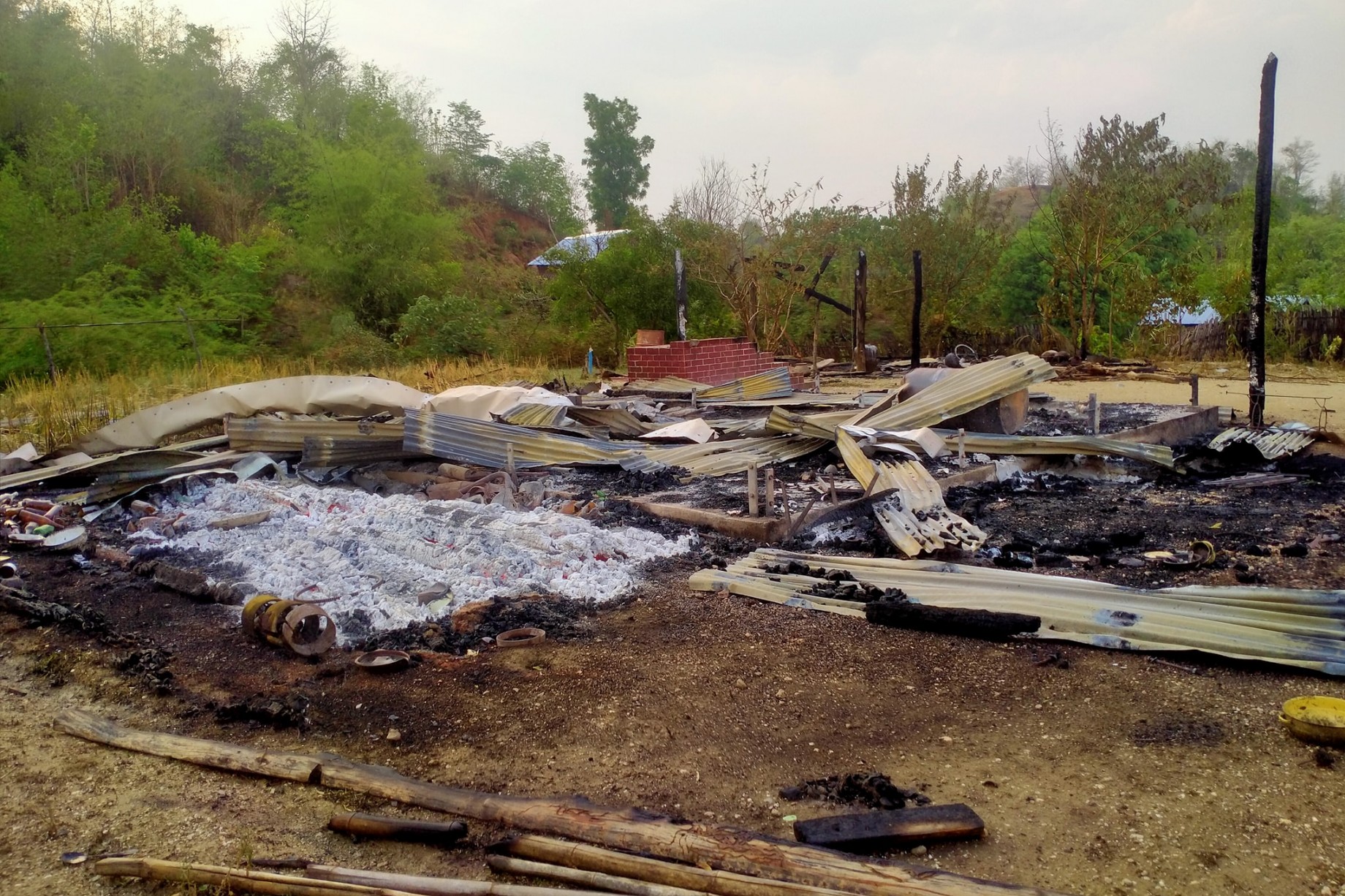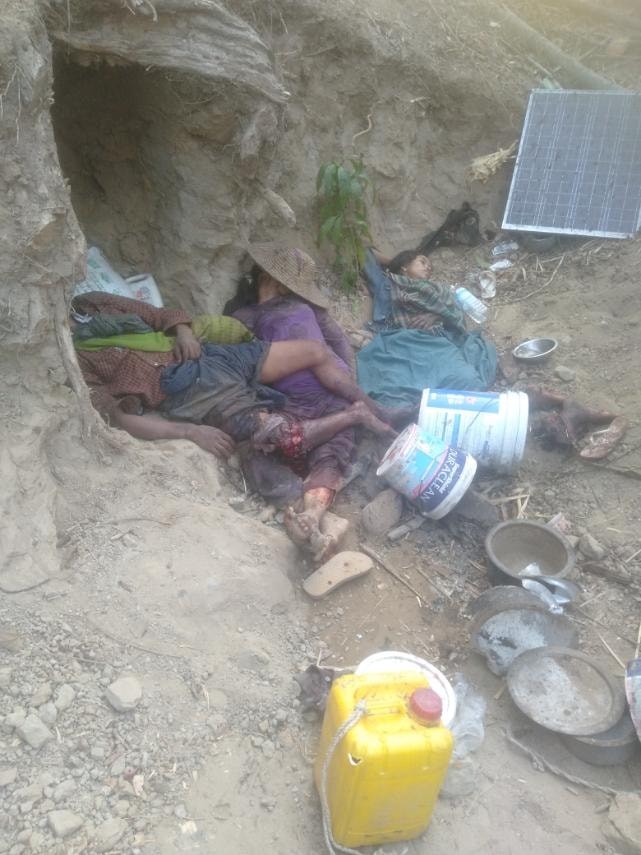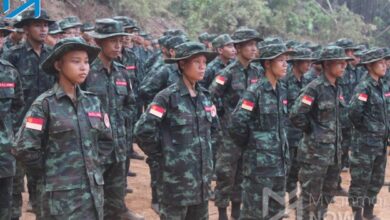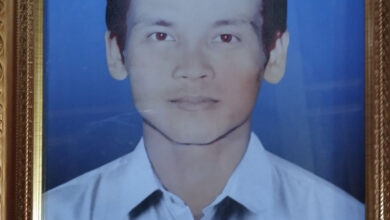
Fighting between the Myanmar army and resistance forces has escalated throughout Magway Region, with guerrilla groups reportedly inflicting significant military casualties after a junta scorched earth campaign destroyed all or part of nearly 20 villages.
Ambushes on military positions by anti-junta defence forces or raids by the Myanmar army have been reported in three townships in western Magway since the second week of April: Htilin, Ngape and Pauk.
During this time, there were more than 30 reported deaths in total, including both civilians and junta troops, according to members of the resistance.
Myanmar Now is unable to independently verify the number of casualties reported during the recent wave of violence in Magway.
The military council has not released any information acknowledging the fighting, its alleged losses or accusations of grave abuses by its troops.
Located in central Myanmar, Magway has been a resistance stronghold since revolutionary forces took up arms nationwide to topple the junta following the February 2021 coup.
PDF overruns police station in Htilin
The Htilin PDF announced on Tuesday that they had carried out an attack on the Kyin village police station two days earlier which resulted in the fatal shooting of the local junta police chief and the capture of the remaining officers.
“We detained the officers who surrendered along with their family members,” a leader within the PDF, Bo La Yaung, told Myanmar Now. “We surrounded the armed officers who tried to flee, and told them to give up their weapons. They surrendered as well.”
He said that the 12 officers and their 11 family members were being held in a “safe location.”

PDF members were also able to confiscate more than 20 firearms during a siege on the station’s armoury, the group’s leader added.
The fighting lasted more than 45 minutes, during which the police chief was killed and two other officers were reportedly injured.
After the PDF’s retreat from the site, a military helicopter reportedly flew over the village of Kyin, located 25 miles east of Htilin’s administrative centre, and opened fire on the community, destroying three homes.
More than 150 reinforcement troops from the No. 24 defence factory marched on the area later that evening, leading to another shootout with the PDF and its allies east of Kyin, the Htilin PDF’s Bo La Yaung said.
On Monday afternoon, the soldiers entered the village on foot. The PDF leader claimed that his fighters had buried dozens of explosive devices in the abandoned police station, which they detonated around 45 minutes after the ground troops arrived at the site.
“It is possible officers were killed,” Bo La Yaung said.
Resistance coalition ambushes military column in Ngape
Some 20 junta soldiers were killed and around 30 injured in Ngape Township during a series of clashes with local resistance coalition the People’s Revolution Alliance (PRA-Magway), according to a statement released by its members on Tuesday.
Between April 8 and April 14, the alliance reportedly engaged in three battles with an 800-soldier military column 16 miles west of Ngape town, and managed to seize multiple junta weapons.

The area is mountainous and thickly forested, bordering Ann Township in Rakhine State. An officer from the PRA-Magway said that their members’ geographic knowledge of the area served as an advantage, even as the junta employed airstrikes and heavy artillery fire on the first day of fighting.
“The main issue is they did not know the area well, and the leaders of the military council do not care about their subordinates. They sent their soldiers to death,” the resistance officer said.
Three members of the PRA-Magway were injured, he added.
While at the time of reporting, fighting had not restarted, members of the PRA-Magway had observed junta forces evacuating injured troops and preparing rations, the officer told Myanmar Now.
“I suppose they will attack again after regaining their strength,” he said.
The military fired heavy artillery at and then occupied the village of Nga Phyu Gyi, 30 miles from the site of fighting, on April 10, a resident said. He was among some 100 villagers who fled their homes in the attack.
“They raided every house in the village,” he said. “They also took property from the church, and burned sacks of rice.”
He told Myanmar Now that the displaced locals had fled with little food and were concerned that they would be unable to obtain more as long as the junta troops remained in Nga Phyu Gyi.
Military razes villages in Pauk
Around 200 junta soldiers raided and burned all or part of 17 villages in Pauk Township between April 10 and April 18, killing 12 civilians during the attacks, according to local sources.
Eight villages were completely lost in the fires, and in nine more, some 600 homes were destroyed.
The campaign follows an ambush by resistance forces on a junta convoy that was carrying arms parts through Pauk in early April, killing some seven officers. The military has been intensifying its assault on villages in the township ever since.
“They have not left the area yet,” a member of the anti-junta People’s Defence Force (PDF) in Pauk told Myanmar Now. “They are trying to make the locals’ lives miserable. The PDF is strong in these areas, and they are causing trouble so that the locals cannot support us.”
The junta column in question was occupying—and had also set fire to—Thet Kei Kyin village in southern Pauk at the time of reporting. They had been seen patrolling and targeting villages in the area south to the township border with Seikphyu.

Some 70 of Thet Kei Kyin’s 500 households were destroyed in the blaze and a 70-year-old woman died of starvation on April 13 during the military occupation, the PDF member said, explaining that she had previously suffered a stroke and was therefore unable to flee with the rest of the residents.
“She didn’t have food to eat,” he added. “There were no villagers left.”
Members of the military unit set fire to the village of Shar Hla on the same day, destroying 20 of its 50 homes. An 80-year-old woman, Khin Than, burned to death, a villager displaced from Shar Hla told Myanmar Now.
Another 30-year-old man from the village—Min Oo—was reportedly killed by a military landmine.
Nine displaced persons from Tasu village, less than eight miles north of Shar Hla, died after being hit by artillery shells fired by junta troops one day earlier on April 12. The military employed the heavy weaponry following an earlier clash with the Pauk PDF near Tasu.
The victims were all from the same family, a man from Tasu said. Among them were seven women and two men.
According to the Pauk PDF member who spoke to Myanmar Now, the soldiers then proceeded to set fire to the village of Kinma, which was targeted in a brutal junta attack last year that destroyed 80 percent of its homes and killed an elderly couple.
He speculated that the second assault on the village was done as an act of “revenge.”
“An explosive detonated while they were marching on their route. They weren’t hit by it but they weren’t happy about it. That’s why they burned the remaining houses in Kinma, for revenge,” he said.
In addition to Kinma, the villages completely destroyed during the recent period in question were Kyauk Kone (also known as Kyauk Oe), Yae Kyaw, Boet Mei, Ingaldauk, Let Pan Hla, Lel Yar and Dainkon. Each community ranged in size from 50 to 200 households.
Those partially burned included Thet Kei Kyin, Shar Hla, and Tasu, as well as Kyun Gyi, Taung Cho, Taung Bet, Zeetaw, Kaingma and Myit Pyar. The Pauk PDF estimated that 600 homes were lost in those communities in total.
“They even burned the tents in the forest. Villagers did not dare to keep their belongings in the village, so they kept them in the forest in these tents,” the PDF member said. “All their belongings were lost in the fire. The main reason for doing that was to stop the villagers from being able to support the PDF.”
More than 10,000 residents of Pauk Township have been displaced by the junta’s raids and arson. At the time of reporting, the military had blocked access to southern Pauk, and subsequently, aid deliveries of food and medicine to the villagers fleeing their attacks.
![Resistance fighters holding heavy weapons ammunition in central Myanmar. (Photo: Freedom Revolution Force [FRF])](https://myanmar-now.org/en/wp-content/uploads/sites/5/2024/04/438869056_443267851680128_1706386881626943924_n-390x220.jpeg)


